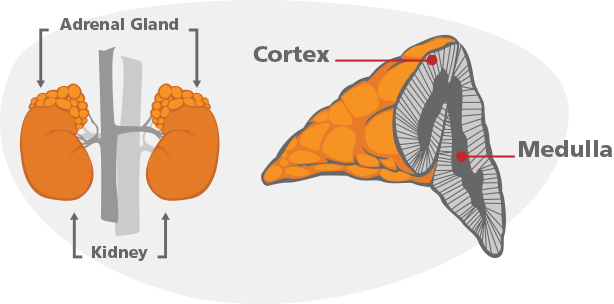Anatomy of the Adrenal Glands
There are normally two adrenal glands, triangular-shaped organs that measure about 1.5 by 3 inches, which are located on top of each kidney. When you think of adrenal glands, stress might come to mind. The adrenal glands are arguably best known for secreting the stress hormones, which rapidly prepare your body to spring into action (flight, fright, fight). But the adrenal glands contribute to your health even at times when your body isn’t under extreme stress. In fact, they release hormones that are essential for you to live.

Adrenal Glands Hormones
An adrenal gland is made up of two distinct parts:
• The adrenal cortex – the outer part of the gland produces glucocorticoid hormones that are vital to life, such as cortisol (which helps regulate metabolism and helps your body respond to stress) and mineralocorticoids, such as aldosterone (which helps control blood pressure by adjusting water and salt levels in the bloodstream).
• The adrenal medulla - the inner part of the gland produces other hormones, such as adrenaline and noradrenaline (which helps your body react to stress).
Adrenal Cortex Hormones
The adrenal cortex hormones, glucocorticoids and mineralocorticoids, are essential hormones that maintain adequate blood flow which maintains oxygen and nutrients to all cells. The release of glucocorticoids is triggered by the hypothalamus and pituitary gland. When the hypothalamus produces corticotrophin-releasing hormone (CRH), it stimulates the pituitary gland to release adrenocorticotrophic hormone (ACTH). These hormones, in turn, alert the adrenal glands to produce glucocorticoid hormones. Mineralocorticoids are mediated by different signals triggered by the kidney.
Hormones released by the adrenal cortex include:
• Hydrocortisone: Commonly known as cortisol, it regulates how the body converts fats, proteins, and carbohydrates to energy. It also helps regulate blood pressure and cardiovascular function.
• Corticosterone: This hormone works with hydrocortisone to regulate immune response and suppress inflammatory reactions.
• Aldosterone: is the mineralocorticoid which maintains the right balance of salt and water while helping control blood pressure.
• Sex Steroids: are released in very small amounts of male and female sex hormones. However, their impact is usually overshadowed by the greater amounts of hormones (such as estrogen and testosterone) released by the ovaries and testes.
Unlike the adrenal cortex, the adrenal medulla does not make hormones which are essential or needed to live. The hormones of the adrenal medulla are released when the sympathetic nervous system is stimulated, which occurs when you are stressed by physical or emotional reasons. You may be familiar with the fight-fright-flight when your body encounters a threatening (stressful) situation. The hormones of the adrenal medulla contribute to the response.
Hormones secreted by the adrenal medulla are:
• Epinephrine: Most people know epinephrine by its other name – adrenaline. This hormone rapidly responds to stress by increasing your heart rate and increasing blood flow to the muscles and brain. It also increases your blood sugar level by helping breakdown the sugar stored in the liver.
• Norepinephrine: Also known as noradrenaline, this hormone works with epinephrine in responding to stress. However, it can cause vasoconstriction (the narrowing of blood vessels). This results in increasing blood pressure in preparing the body to stress.
Disorders and Diseases of the Adrenal Glands
There are multiple reasons why the adrenal glands might not work as they should. The problem could be with the adrenal gland itself, or the root cause may be due to a defect in another gland.
Below are the most common disorders and diseases of the adrenal glands:
• Addison’s Disease: This rare disorder may affect anyone at any age. It develops when the adrenal cortex is destroyed and fails to produce enough cortisol and aldosterone.
• Cushing’s Syndrome: Cushing’s syndrome is an uncommon condition that is caused by overproduction of the hormone cortisol. There are a variety of causes of this disorder, a tumor in the adrenal gland or pituitary gland can lead to an overproduction of cortisol.
• Congenital Adrenal Hyperplasia: This genetic disorder is characterized by low levels of cortisol. It’s common for people with congenital adrenal hyperplasia to have additional hormone problems such as low levels of aldosterone (which maintains a balance of water and salt). In women, this disorder may present with abnormal menses or hirsutism.
• Adrenal Cancer: Adrenal cancer is an aggressive cancer, but it’s very rare. Malignant adrenal tumors are rarely confined to the adrenal glands and spread rapidly to other organs and produce high levels of adrenal hormones.
![]()












